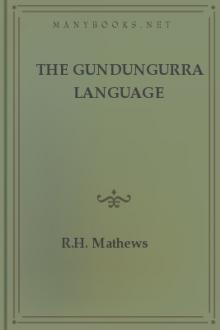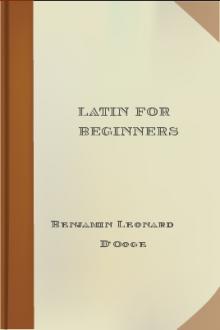The Gundungurra Language by R. H. Mathews (novel books to read txt) 📕

- Author: R. H. Mathews
- Performer: -
Book online «The Gundungurra Language by R. H. Mathews (novel books to read txt) 📕». Author R. H. Mathews
The Project Gutenberg EBook of The Gundungurra Language, by R. H. Mathews
This eBook is for the use of anyone anywhere at no cost and with almost no restrictions whatsoever. You may copy it, give it away or re-use it under the terms of the Project Gutenberg License included with this eBook or online at www.gutenberg.org
Title: The Gundungurra Language
Author: R. H. Mathews
Release Date: June 19, 2007 [EBook #21866]
Language: English
*** START OF THIS PROJECT GUTENBERG EBOOK THE GUNDUNGURRA LANGUAGE ***
Produced by anonymous
THE GUNDUNGURRA LANGUAGE. BY R. H. MATHEWS, L.S.(Read October 4, 1901.)
The Dhar′rook and Gun′dungur′ra tribes respectively occupied the from the mouth of the Hawkesbury river to Mount Victoria, and thence southerly to Berrima and Goulburn, New South Wales. On the south and southeast they were joined by the Thurrawal, whose language has the same structure, although differing in vocabulary.
Besides the verbs and pronouns, many of the nouns, adjectives, prepositions and adverbs are subject to inflection for number and person. Similar inflections have, to some extent, been observed in certain islands of the Pacific Ocean, but have not hitherto been reported in Australia. I have also discovered two forms of the dual and plural of the first personal pronoun, a specialty which has likewise been found in Polynesian and North American dialects. Traces of a double dual were noticed by Mr. Threlkeld at Lake Macquarie, New South Wales, and traces of a double plural by Mr. Tuckfield in the Geelong tribe; but the prevalence of both forms of the dual and plural in different parts of speech in any Australian language has, up to the present, escaped observation.
Orthography.
Ninteen letters of the English alphabet are sounded, comprising fourteen consonants—b, d, g, h, j, k, l, m, n, p, r, t, w, y—and five vowels—a, e, i, o, u. Every word is spelled phonetically, the letters having the same value as in English, with the following qualifications:
Unmarked vowels have the usual short sound.
Vowels having the long sound are distinguished by the following marks:
ā as in fate ī as in pie oo as in moon
â as in father ô as in pole ee as in feel
ou as in loud
It is frequently difficult to distinguish between the short or unmarked sound of a and that of u. A thick or dull sound of i is occasionally met with, which closely approaches the short sound of u or a.
G is hard in every instance.
R has a rough trilled sound, as in hurrah!
Ng at the beginning of a word, as ngee=yes, has a peculiar sound, which can be got very closely by putting oo before it, as oong-ee′, and articulating it quickly as ony syllable. At the end of a word or syllable it has substantially the sound of ng in our word sing.
The sound of the Spanish ñ is frequent, both at the beginning or end of a syllable.
Y, followed by a vowel, is attached to several consonants, as in dya, dyee, tyoo, etc., and is pronounced therewith in one syllable, the initial sound of the d or other consonant being retained. Y at the beginning of a word or syllable has its usual consonant value.
Dh is pronounced nearly as th in “that” with a slight sound of the d preceding it.
Nh has nearly the sound of th in “that” with an initial sound of the n.
The final h is guttural, resembling ch in the German word “joch.”
T is interchangeable with d, p with b, and g with k in most words where these letters are employed.
A sound resembling j is frequently given by the natives, which can be represented by dy or ty; thus, dya or tya has very nearly the same sound as ja.
In all cases where there is a double consonant, each letter is distinctly enunciated.
W always commences a syllable or word and has its ordinary consonant sound in all cases.
At the end of a syllable or word, ty is sounded as one letter; thus, in beety-bal-lee-mañ, it is disappearing, the syllable beety can be obtained by commencing to say “beet-ye,” and stopping short without articulating the final e, but including the sound of the y in conjunction with the t—the two letters being pronounced together as one.
Articles.
The equivalents of the English articles, “a” and “the,” do not occur in this language.
Nouns.
Number.—Nouns have the singular, dual and plural:
(1) Singular A man Murriñ
Dual A pair of men Murriñboolallee
Plural Several men Murriñdyargang
(2) Singular A kangaroo Booroo
Dual A pair of kangaroos Booroolallee
Plural Several kangaroos Boorooyargang
It will be observed that the dual and plural suffixes vary slightly in form, according to the termination of the noun.
Gender.—Mur′riñ, a man; bul′lan, a woman; boobal, a boy; mullunga, a girl; goodha, a child of either sex; warrambal, a young man. Another name for a man is boual; a married man is kunbeelang; a married woman is boualillang. Generally the males of animals are distinguished by the addition of goomban, and the females by dhoorook. The males of certain animals have a name which distinguishes them without stating the sex; thus, the male of wallee, the opossum, is known as jerrawul, while the female is wallee dhoorook. Goola, the native bear, has burrandang for the male and goola dhoorook for the female. A few animals have a distinctive word for the female as well as for the male; thus, the female of the wallaroo is bâwa, and the male goondarwâ. Others again have the suffix koual for the male, and ñoual for the female. The words for “male” and “female” are inflected for number like other adjectives.
Case.—There are two forms of the nominative, the first naming the subject at rest; as Boual ngabooromañ, the man sleeps. The second shows that the subject is doing some act; thus, mirreegangga wallee burrârañ, the dog an opossum bit. Mirreegang is a dog in the first nominative.
The possessive case takes a suffix both to the possessor and that which is possessed:
Murringoo warrangangoong, a man’s boomerang.
Mirreegangoo goodhâwoong, a dog’s puppy.
Bullangoo goodhâyarroong, a woman’s children.
Booroongoo dhoombirgoong, a kangaroo’s tail.
Any object over which one can exercise ownership can be conjugated by possessive suffixes for number and person:
Singular. First person My boomerang Warrangandya
Second Person Thy boomerang Warranganyee
Third Person His boomerang Warrangangoong
Dual. First Person Our boomerang, incl. Warrangangulla
Our boomerang, excl. Warrangangullang
Second Person Your boomerang Warranganboola
Third Person Their boomerang Warranganboolangoo
Plural. First Person Our boomerang, incl. Warranganyinnang
Our boomerang, excl. Warranganyillung
Second Person Your boomerang Warranganyoorung
Third Person Their boomerang Warrangandyunnung
The accusative does not differ from the nominative. There are a few forms of nouns for the dative and oblative, but these cases are frequently shown by modifications of the verb; as, I carried to him, he carried from me. They are also indicated by the pronouns; as, with me, to me.
Pronouns.
Pronouns are inflected for number, person and case. There are two forms of the dual and plural in the first person. The following table shows the nominative and possessive cases:
Singular. I Goolangga Mine Goolanggooya
Thou Goolanjee Thine Goolanyingoo
He Dhannooladhoo His Dhannoogoolangoo
Dual. We, incl. Goolanga Ours, incl. Goolangalīa
We, excl. Goolangaloong Ours, excl. Goolangaloong
Ye Goolamboo Yours Goolambooloong
They Dhannooboola Theirs Dhannooboolangoo
Plural. We, incl. Goolanyan Ours, incl. Goolanyannung
We, excl. Goolanyilla Ours, excl. Goolanyillungoon
Ye Goolambanoo Yours Goolanthooroong
They Dhannoojimmalang Theirs Goolangandyoolang
These possessives admit of variations to include two or several articles and in other ways. There are also forms of the pronouns signifying, with me, with thee, and so on as follows:
Singular. First Person With me Goolangngooreea
Second Person With thee Goolangooroonyee
Third Person With him Goolangooroong
Dual. First Person With us, incl. Goolangooroongulla
With us, excl. Goolangooroongullung
Second Person With ye Goolangoorooloong
Third Person With them Goolangooroolangoo
Plural. First Person With us, incl. Goolangoorooñunnung
With us, excl. Goolangoorooñullungoo
Second Person With ye Goolangoorooñooroong
Third Person With them Goolangooroodyunnung
There are other modifications of the pronouns to meet different forms of expression. The demonstratives and interrogatives are inflected for number and person like the rest.
Adjectives.
Adjectives take the same dual and plural numbers as the nouns with which they are used:
(1) Barrī buggarabang A wallaby, large
Barrīwoolallee buggarabangoolallee A couple of wallabies, both large
Barrīdyargang buggarabangargang Several wallabies, all large
(2) Bullan yeddung A woman pretty
Bullanboollee yeddungboolallee A couple of pretty women
Bullandhar yeddungdyargang Several pretty women
Comparison is effected by saying, This is heavy—that is heavy; this is smooth—that is not; this is sharp—that is very sharp.
When used predicatively, as yooroang or yoorwang, he is strong, an adjective can be conjugated through all the tenses and moods of an intransitive verb:
Present Tense.
Singular. First Person I am strong Yooroangga or Yoorwangga
Second Person Thou art strong Yooroandyee
Third Person He is strong Yooroang
Dual. First Person We are strong, incl. Yooroanga
We are strong, excl. Yooroangaloong
Second Person Ye are strong Yooroangboo
Third Person They are strong Yooroangboola
Plural. First Person We are strong, incl. Yooroanyun
We are strong, excl. Yooroanyulla
Second Person Ye are strong Yooroanthoo
Third Person They are strong Yooroanjimmalang
The past and future tenses are not given, owing to want of space.
Verbs.
Verbs





Comments (0)